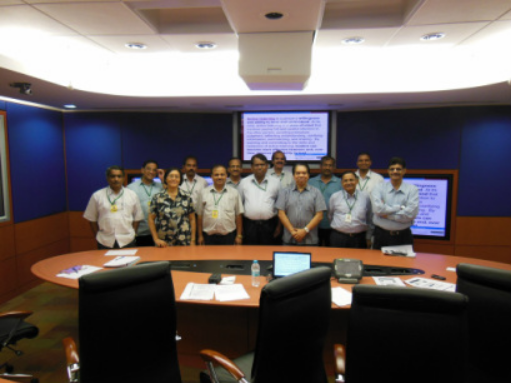
HR Perspectives
Throwback blog from 09/02/2013 by Atty. Hector V Hernandez:
HR PERSPECTIVES IN THE SEMI-ARID TROPICS (SAT) RESEARCH FACILITY – SOUTH ASIA

Every day of every week as the HR Manager goes to work, he needs to adapt to the changing everyday challenges in his work. Today he is a Problem Solver; tomorrow he is a Mentor and a Coach; the next day he is an Innovator or a Trainer; and during a Management meeting, he gets the blame for the lack of quality recruits required by the line managers to deliver the required results of the business.
The HR function has completely evolved over the last 30 years as we now see the Head of HR becoming more of the main Catalyst for Change in organizations, whether for profit or non-profit; whether that change is to move forward to a competency-based model of HR Management or simply transforming that paper-based Performance Appraisal Form to an online system or maybe influence the mindset of old staff members to embrace new and tested processes for them to work more efficiently and effectively.

Catalyst Role of HR
To understand the catalyst role of HR is for HR to accurately read the culture of the organization mostly gleaned from the way the staff members or people are behaving. And perhaps this is why some modern thinking organizations, both in the West and the East, have replaced the nomenclature Head of HR to Head of People or HP. As a Catalyst of Change in typical organizations, the CEO now demands from the HP a clear and accurate reading of staff members’ needs and wants so that the organization can adapt its people strategies and align the same with its business goals.
At the International Crops Research Institute for the Semi-Arid Tropics (ICRISAT), one area of concern is work-life effectiveness in the workplace. After reading the results of the latest engagement survey among scientists and managers in the research facility, where “work life balance” or WLB received only 23% agreement, Management consulted HR on how to improve this impression or perception from the staff. An Open Space Technology (OST) approach was conducted where about 50% of the target population showed up in the Academic Court premises to discuss what scientists and managers really mean when they gave WLB a low score. The scientists and managers provided inputs in an hour workshop; and their creative ideas were collated and discussed with a WLB consultant for action planning and execution.
Another area of concern in most organizations is how to harvest the collective ideas of a diverse group. In one management meeting in the research center, it was pointed out that more women scientists and managers should be included in committees and task forces for them to deliberate ideas with men scientists and managers in an assertive manner. This is a way to cultivate a culture of diverse thinking in the organization. After consulting with our Gender and Diversity Associates (GDAs), a framework for success was devised to ensure an increasing number of women scientists and managers participating in committees and task forces.

Employee Engagement
Nothing beats an engaged staff member. Dennis Kinlaw’s work on commitment is instructional for us HR Managers. He states that “for an organization to stand the test of time there must be high levels of employee engagement.” He has simplified the complex for us and consolidated the array of much studied motivators into four (4) factors which he calls the Pillars of Commitment. There is no one action that will ensure employee commitment or engagement. Research has indicated that an environment of engagement needs to be nurtured by both Management and staff members.
Kinlaw identified four (4) key areas that reinforce a culture of engagement as: Clarity, Competence, Influence, and Appreciation.
Engagement is enhanced when there is clarity about the organization’s mission, goals, objectives and expectations. Clarity ensures focus and staff member knows that his own work-plan or targets are aligned with the bigger goals of the organization. This may sound easy as you may have your own performance management process, which includes goal setting and setting KPIs. The key to success here is to have continuing feedback. Writing the targets is just one part; but for both staff member and supervisor, to monitor actual performance over a period of time and act on the results, is oftentimes more challenging. But indeed, it is the beginning for an engaged staff member. (Please check this out if properly punctuated. I may have revised thought flow.)
But how can we be expected to deliver on our expectations if we are not geared up to deliver results? To be and feel competent, one must have the right tools, appropriate resources, right knowledge, skills, and practical support.
After all these surveys, staff members expect that something will work out for the better in the organization; that Management will act on what “we indicated in the verbatim part of the survey.” Staff members may want to communicate with and give feedback to Management through various devices, venues or mechanisms – e.g. speak up program, skip level meetings, focused group discussion, survey, etc. For the staff members to be engaged, they need to be able to have a measure of influence. Unfortunately, by conducting a survey and then failing to communicate the results, the staff members become even more disengaged.
One of the basic courtesies we learned when we were children was to say “thank you.” It is such a basic lesson in social grace and yet it amazes us adults when we see our colleagues not showing genuine appreciation for a job well done or simply downplaying a good job by saying: “He or she is paid for that anyway.” At ICRISAT, I devised a very simple Thank You Card for line managers and made this more accessible to them off-line. In this online environment, the staff member feels much more appreciated if he or she receives a note of appreciation specifically written by the boss. This is truly a very simple but powerful tool to make staff members more engaged.
There are a thousand words which could describe the roles of HR in diversity and global competitiveness. Maybe read and learned from informative sources but quite daunting to put in actual practice. But it can be done if one is truly engaged!
More from Our Blog…
Workplace Learning and Performance
Whenever I discuss with my line managers regarding their concerns on running an important skills building program or intervention for…
Informal Recognition
Nearly every supervisor knows that employees want to be valued and appreciated especially when they do a good job e.g….
50th PMAP Anniversary Plenary Speech
Speech delivered to the plenary session of the 50th Annual Conference of the People Management Association of the Phils (PMAP)…







Leave a Reply